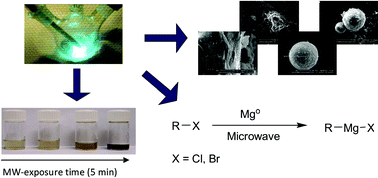Microwave-induced electrostatic etching: generation of highly reactive magnesium for application in Grignard reagent formation†
Abstract
A detailed study regarding the influence of microwave irradiation on the formation of a series of

* Corresponding authors
a
Eindhoven University of Technology, Department of Chemical Engineering and Chemistry, Laboratory of Macromolecular and Organic Chemistry, Applied Organic Chemistry, P.O Box 513, Eindhoven, the Netherlands
E-mail:
L.A.Hulshof@tue.nl
b Eindhoven University of Technology, Department of Chemical Engineering and Chemistry, Process Development Group, P.O Box 513, Eindhoven, The Netherlands
A detailed study regarding the influence of microwave irradiation on the formation of a series of

 Please wait while we load your content...
Something went wrong. Try again?
Please wait while we load your content...
Something went wrong. Try again?
B. H. P. van de Kruijs, M. H. C. L. Dressen, J. Meuldijk, J. A. J. M. Vekemans and L. A. Hulshof, Org. Biomol. Chem., 2010, 8, 1688 DOI: 10.1039/B926391H
To request permission to reproduce material from this article, please go to the Copyright Clearance Center request page.
If you are an author contributing to an RSC publication, you do not need to request permission provided correct acknowledgement is given.
If you are the author of this article, you do not need to request permission to reproduce figures and diagrams provided correct acknowledgement is given. If you want to reproduce the whole article in a third-party publication (excluding your thesis/dissertation for which permission is not required) please go to the Copyright Clearance Center request page.
Read more about how to correctly acknowledge RSC content.
 Fetching data from CrossRef.
Fetching data from CrossRef.
This may take some time to load.
Loading related content
